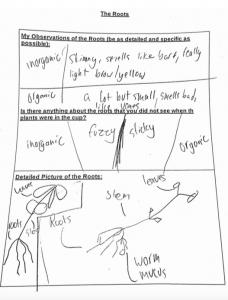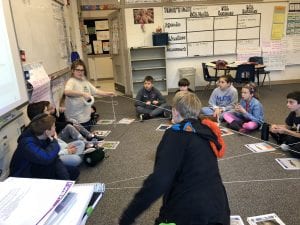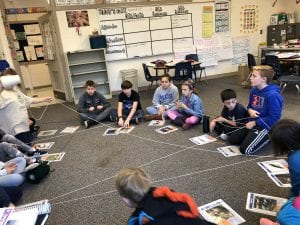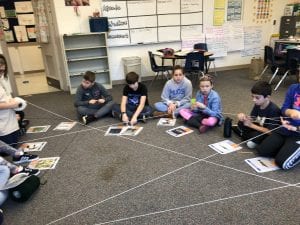5th graders just wrapped up their unit on adding, subtracting, and comparing fractions! Your children worked so hard on their final test and it showed. This week, we started our next unit on decimals. We began talking about place value, what it means, and we related the different place values to money. We also spent time discussing how these decimal numbers are directly connected to fractions. We showed this by writing out our decimal numbers in expanded form using fractions. Students practiced this by breaking apart decimals like 0.452 and rewriting it in expanded form: 4/10 + 5/100 + 2/1000 or (4 x 1/10) + (5 x 1/100) + (2 x 1/1000). We also discussed how to represent decimals as fractions using place value (0.452 = 452/1000).
One thing that I am working on as a teacher is creating more challenges for your children when they understand something and feel that it is “too easy”. I always want your child to feel as though they are being challenged and are learning something new. Luckily, I have so many wonderful MJDS teachers to help me with this. Already, I have learned so much from both the kids and my fellow coworkers and I am slowly figuring out different ways to (hopefully) challenge your children.
This week in 5th grade science, we spent a lot of time talking about the importance of recording detailed, specific observations and why scientists are required to do this. We then practiced by looking at our plants grown in organic soil and our plants grown in perlite (inorganic material, ask your kids, they know A LOT about this :)). Students had to record everything about each plant sample, from the texture of the leaves, to the sturdiness of the stem, to the height of the plant. They also had to draw an accurate representation of each plant that a stranger would be able to understand. I saw so much growth from every student throughout this activity. Students took time to really study the plant. They touched the leaves, felt the stem, used rulers to measure multiple parts of the plants, and examined the bottom of the cup to see the roots. They were pointing out things that I had not even noticed, which was so cool to hear and see. This process of observing, recording, and explaining is something that we will continue to practice throughout the entire year. I am so excited to continue to watch them grow!


This week in 6th grade science your children have been hard at work creating a food web based on a specific ecosystem of their choice. Students were required to figure out what types of organisms lived in their ecosystem and research what they consumed or if they produced their own food. They then had to show how all the organisms were connected by showing which way the energy was flowing from organism to organism. Students dove deep into understanding the terms consumer, producer, predator, prey, decomposer, herbivore, carnivore, and omnivore as they had to describe each organism on their food web as one or more of these terms. I was so impressed with how students worked together while completing this project. I heard things like, “Hey, what do you think of this idea?, “Wow, I love how you drew that!” and “Great idea! I agree!” Students showed so much empathy and kindness to each other while working in their groups and because of that every group’s poster turned out beautifully. In the next week or so (depending on when our shipment arrives) students will be dissecting two different types of organisms to analyze how an animal’s structure contributes to its ability to obtain food and reproduce. I can’t wait!

The past few weeks in 5th grade math we have been focusing on solving addition and subtraction with fractions in word problems. The kids have been doing such a great job with them. This past Tuesday, with a partner, students worked together to solve a word problem. I was so impressed with how every student really embraced our 5th grade promise statements while doing this work. I saw students asking their partner for help when they did not understand something. I saw students explaining the problem until their partner understood in such a kind, empathetic way. I saw that when a group made a mistake both partners worked together to figure out the correct answer without getting frustrated or down on themselves. It was amazing to see! I am so excited to continue this work over the course of the year. The kids are doing such a great job teaching each other how to solve the problem and are able to think and solve them in so many different ways. I am learning so much from them every day. If you are curious to see the word problem they solved and the work they did to solve it, check out your student’s blog post!
Our first unit in 6th grade science this year is based on investigating the question, “What can cause populations to change?” Within that question we are focusing on four main components that drive population change: food, reproduction, environment, and other organisms. So far, we have been investigating the purpose of food and the impact it has on a population of organisms in an ecosystem. Over the past few weeks we have been testing how we know something is a food by testing it for carbohydrates, proteins, and fats. This week, we moved on to investigating and examining food chains and food webs where we discussed producers, consumers, predator, prey, and direct and indirect interactions. This past Wednesday we created a class food web to visually see how multiple organisms interact and depend on one another to live. We also discussed how the impact of losing one species from our food chain effects other species. The kids did a great job at listening to each other and helping each other out as we created our giant food web. It was so cool to see all the different food chains we created within our web once we were done.
I have been so impressed with the 6th graders and their thoughtful questions and comments based on what we are studying. I am so excited to continue to watch them grow and learn as the year goes on. In the next few weeks we will have the opportunity to dissect two different types of fish. Be prepared to see some icky pictures!!



Hi 5th and 6th grade families,
I am so excited to start blogging this year. The kids have already taught me so much about what blogging is and how blogging works here at MJDS (I am definitely learning so, so much from them). Although our first month or so of school has been sparse with full weeks, I have loved every second of our days at school. From studying worms and moldy bread in 5th science, to testing foods for fats, carbs, and protein in 6th science, to studying and learning all about fractions in 5th math, our days have been jam packed and loads of fun.
In my future blog posts, I will always try to separate them by class so it is easy to see what is going on in each subject area. Thank you again to all of the MJDS students and families who made my transition into the school so easy. I am so happy to be a part of this school community and cannot wait for our year ahead!
Cheers to this 2018-2019 school year!
Excitedly,
Gev. McAdams





